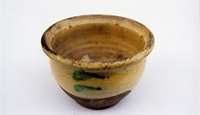
Applicant:
Lapithos Municipality
Communities Concerned - Bearers of the element:
Potters from Lapithos, Lapithos Municipality, Lapithos Cultural Foundation, “Lapithos” Refugee Association, Ephorate of Lapithos schools
Domain of Intangible Cultural Heritage:
Traditional craftsmanship
Date of inscription:
2016
Geographical distribution:
The art of glazed pottery, which comes from Byzantium, appeared in Paphos and Lapithos in the 14th century AD. In Lapithos it has been preserved over the years, while in Paphos it lasted for a period of less than a century. The art is passed on to this day from the older generations of experienced potters from Lapithos, who teach at their workshops. The production of pottery continues in the traditional way, with the exception that the baking takes place in electric ovens and the clay is imported from abroad. The number of female potters has reduced significantly.
Brief description:
The glazed pottery of Lapithos was established under the common name aleifta pottery of Lapithos or lapithkiotika aleifta. It is the only watertight kind of pottery, which can only be found in Lapithos, as opposed to the porous pottery that can be found in the rest of Cyprus. Depending on their use, they had various names: mpotis (jug), to store and serve drinking water and wine; kourellos (vase or urn) to store products such as lentils, olives in their salt water, halloumi cheese and more. The mpotis had a handle, while the kourellos mostly had two, while in some cases it had three. The kouppa (bowl) and plate were for everyday use and came in different sizes. Other objects include the fizes (in various sizes, used to store various foods, sugar, salt, sweets, yoghurt, pickles etc.) Yoghurt would be sold in aleiftes fizes, the so-called kkesedes or kkiasedes. Fruit bowls and decorative vases were also very popular.
The raw material for pottery was - and continues to this day to be - clay, which in the case of Lapithos pottery must be of very good quality, free of foreign matter, sticky and fine. This type of clay, which can only be found in Lapithos, was named kouliastos, from the way it is processed.
In the early 20th century, during World War I and the period after that, the descent of the Asia Minor craftsmen proved an important landmark in the history of Lapithos pottery making. Oriental potters, excellent craftsmen and foremen settled down and worked in Lapithos, bringing with them the secrets of their art, which they gradually passed on to the local craftsmen they cooperated with. This cooperation had a very positive outcome for local potters, as the oriental potters came from renowned ceramic factories in their country and were extremely skilled in their art. On their arrival in Lapithos, the oriental potters initially worked at the famous pottery shop of Costas Christodoulakis, which besides producing pottery, started training new potters.
The art of pottery is deeply rooted in Lapithos and inseparably linked to the inhabitants. Some craftsmen would add the capacity “Potter” after their signature on their creations, as it was considered a special honour. The Koupparis family took its surname from its predecessors; potters specialising in the creation of kouppes (bowls) and plates, while there are many more such examples.